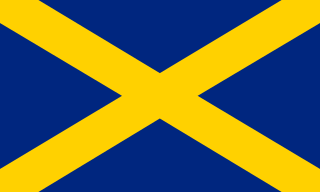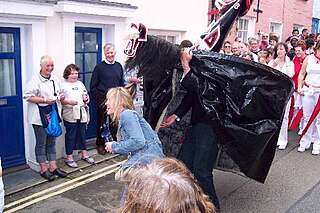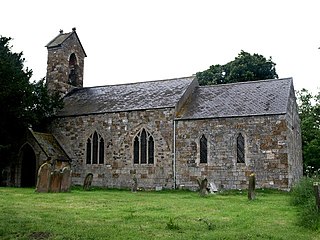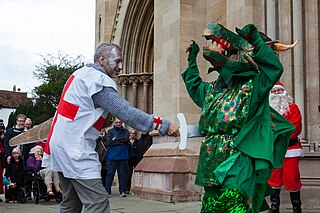Related Research Articles

The Midlands is the central part of England and a cultural area that broadly corresponds to the early medieval Kingdom of Mercia. The Midlands region is bordered by Northern England and Southern England. The Midlands were important in the Industrial Revolution of the 18th and 19th centuries. Two of the nine official regions of England are the West Midlands and East Midlands. Birmingham, in the West Midlands, is the second-largest city and metropolitan area in the United Kingdom.

Hoodening, also spelled hodening and oodening, is a folk custom found in Kent, a county in south-eastern England. The tradition entails the use of a wooden hobby horse known as a hooden horse that is mounted on a pole and carried by an individual hidden under a sackcloth. Originally, the tradition was restricted to the area of East Kent, although in the twentieth century it spread into neighbouring West Kent. It represents a regional variation of a "hooded animal" tradition that appears in various forms throughout the British Isles.
Border Morris is a collection of individual local dances from villages along the English side of the Wales–England border in the counties of Herefordshire, Worcestershire and Shropshire. They are part of the Morris dance tradition.

Byard's Leap is a hamlet in the North Kesteven district of Lincolnshire, England. It is situated approximately 3 miles (5 km) west from Cranwell, and is part of the civil parish of Cranwell, Brauncewell and Byard's Leap. The hamlet is associated with various legends.

Golowan is the Cornish language word for the Midsummer celebrations in Cornwall, UK; widespread prior to the late 19th century and most popular in the Penwith area and in particular Penzance and Newlyn. The celebrations were centred on the lighting of bonfires and fireworks and the performance of associated rituals. The midsummer bonfire ceremonies were revived at St Ives in 1929 by the Old Cornwall Society and since then spread to other societies across Cornwall, as far as Kit Hill near Callington. Since 1991 the Golowan festival in Penzance has revived many of these ancient customs and has grown to become a major arts and culture festival; its central event 'Mazey Day' now attracts tens of thousands of people to the Penzance area in late June.
Tiddy Mun was a legendary bog spirit in Lincolnshire, England, who was believed to have the ability to control the waters and mists of The Fens of South Lincolnshire and The Carrs of North Lincolnshire.

The Mari Lwyd is a wassailing folk custom found in South Wales. The tradition entails the use of an eponymous hobby horse which is made from a horse's skull mounted on a pole and carried by an individual hidden under a sackcloth. It represents a regional variation of a "hooded animal" tradition that appears throughout Great Britain.

The 'Obby 'Oss festival is a folk custom that takes place each May Day in Padstow, a coastal town in North Cornwall. It involves two separate processions making their way around the town, each containing an eponymous hobby horse known as the 'Obby 'Oss.

In the coastal town of Minehead, located in the southwest English county of Somerset, there is a folk custom on May Day entailing the parading of a brightly decorated hobby horse around the locality.

The Dorset Ooser is a wooden head that featured in the 19th-century folk culture of Melbury Osmond, a village in the southwestern English county of Dorset. The head was hollow, thus perhaps serving as a mask, and included a humanoid face with horns, a beard, and a hinged jaw which allowed the mouth to open and close. Although sometimes used to scare people during practical jokes, its main recorded purpose was as part of a local variant of the charivari custom known as "skimity riding" or "rough music", in which it was used to humiliate those who were deemed to have behaved in an immoral manner.

Fulstow is a marsh village and civil parish in the East Lindsey district of Lincolnshire, England. It is situated 6 miles (10 km) north of Louth and 8 miles (13 km) south of Grimsby.

The term 'hobby horse' is used, principally by folklorists, to refer to the costumed characters that feature in some traditional seasonal customs, processions and similar observances around the world. They are particularly associated with May Day celebrations, mummers' plays and the Morris dance in England.
The Winster Guisers are a group who perform a traditional mummers play in and around the village of Winster, Derbyshire, UK, during the Christmas season. Their performance is based on a photograph taken c. 1870 outside Winster Hall showing an unidentified set of performers about whom little is known for certain. The Winster Guisers' play is not local to the area, but is a revival of a Cheshire play, chosen because it features a hobby horse similar to the one in the centre of the old photograph. A "guiser" is someone in disguise, though in the Winster area the term was widely used for the teams of Christmas mummers.
Maurice Willmore Barley was an English historian and archaeologist, specialising in medieval settlements and historic buildings.

Old Tup, sometimes termed the Derby Tup or the Derby Ram, is a folk custom found in an area of north-eastern England. Geographically, the custom was found on the borders of Derbyshire and Yorkshire and stretched into part of Nottinghamshire. The tradition entails the use of a hobby horse with a goat's head that is mounted on a pole and carried by an individual hidden under a sackcloth. It represents a regional variation of a "hooded animal" tradition that appears in various forms throughout the British Isles. In geographical location and style it displays strong similarities with the Old Horse custom, but in the latter the hobby horse was presented as a horse rather than a goat.
Old Ball is a folk custom that existed in the Forest of Rossendale in Lancashire, north-western England during the nineteenth century. The tradition entailed the use of a hobby horse that is mounted on a pole and carried by an individual hidden under a sackcloth. It represents a regional variation of a "hooded animal" tradition that appears in various forms throughout the British Isles.

Old Horse was a folk custom found in an area of north-eastern England. Geographically, the custom was found in Nottinghamshire, Derbyshire, and part of Yorkshire. The tradition entails the use of a hobby horse that is mounted on a pole and carried by an individual hidden under a sackcloth. It represents a regional variation of a "hooded animal" tradition that appears in various forms throughout the British Isles. In geographical location and style it displays strong similarities with the Old Tup custom, but in the latter the hobby horses was presented as a goat rather than a horse.
The Broad was a folk custom found in the Cotswolds, an area of south-central England, during the nineteenth and early twentieth centuries. The tradition entails the use of a hobby horse with a bull's head that is mounted on a pole and carried by an individual hidden under a sackcloth. It represents a regional variation of a "hooded animal" tradition that appears in various forms throughout the British Isles.
Láir Bhán is a hobby horse that was part of a folk custom found in parts of Ireland, particularly in the area of County Kerry, in the eighteenth and nineteenth centuries.

Mummers' plays are folk plays performed by troupes of amateur actors, traditionally all male, known as mummers or guisers. It refers particularly to a play in which a number of characters are called on stage, two of whom engage in a combat, the loser being revived by a doctor character. This play is sometimes found associated with a sword dance though both also exist in Britain independently.
References
Footnotes
Bibliography
- Cawte, E. C. (1978). Ritual Animal Disguise: A Historical and Geographical Study of Animal Disguise in the British Isles. Cambridge and Totowa: D.S. Brewer Ltd. and Rowman and Littlefield for the Folklore Society. ISBN 978-0-8599-1028-6.CS1 maint: ref=harv (link)
- Hutton, Ronald (1996). The Stations of the Sun: A History of the Ritual Year in Britain . Oxford: Oxford University Press. ISBN 978-0-1982-0570-8.CS1 maint: ref=harv (link)
Further reading
- Baskervill, Charles Read (1924). "Mummers' Wooing Plays in England". Modern Philology. 21 (3): 225–272. doi:10.1086/387500. JSTOR 433298. S2CID 161428438.
- Cawte, E. C. (1977). The Wooing Play in the Midland Wolds. Sheffield: Centre for English Cultural Traditions and Language.
- Cawte, E. C.; Helm, Alex; Peacock, N. (1967). English Ritual Drama. London: The Folklore Society.
- Rudkin, Ethel H. (1933). "Lincolnshire Folklore". Folklore. xliv: 282.